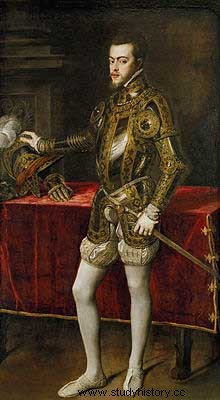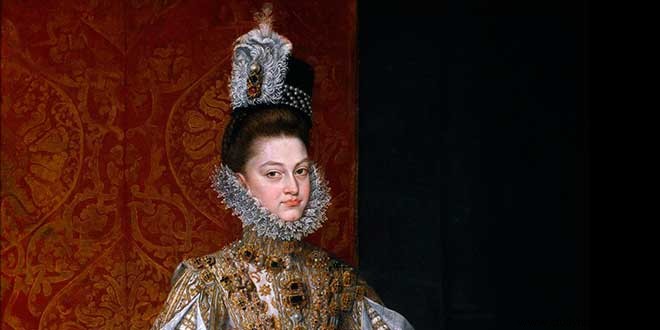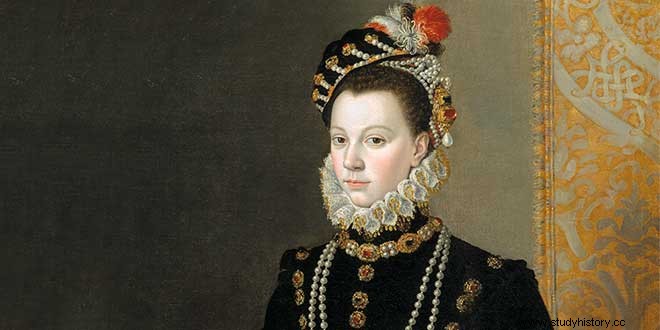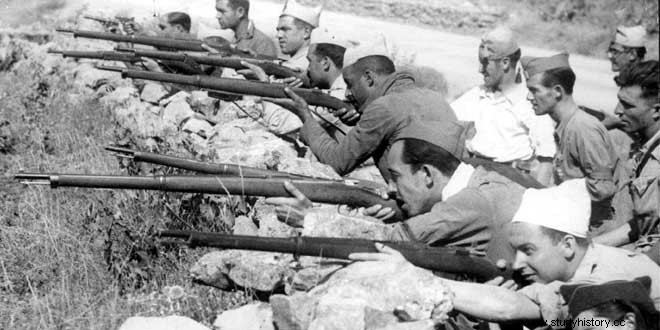Philip II. Kingdom between 1555 and 1598. King of the crowns of Castile, Aragon and Portugal . He was born on May 21, 1527 in Valladolid. He was the son of Carlos I and his wife Isabel (daughter of Manuel I of Portugal). He came to the throne after his father abdicated him in Brussels in 1555 and 1556. Philip II's domains then included, in addition to the territory in the Iberian Peninsula, Europe (Naples, Sardinia, Sicily, Milanese, Roussillon, the Balearic Islands, the Netherlands and Franche-Comté); in Africa (the Canary Islands); in America (Mexico, Peru, Chile, Cuba, Santo Domingo, etc.), and in Oceania (the Philippine Islands and part of the Moluccas); so “in his dominion the sun never set” . But he also inherited from his father the war with France, whose king, Henry II (1547-1559), was an ally of Pope Paul IV (1555-1559).
France-confrontation
The French began the conflict by invading the domains of Felipe II in Italy; but they were rejected by the Duke of Alba; so the Pope broke away from the alliance with France. Philip II was married to Mary Tudor and received the news of the French aggression while in England; He immediately assembled an army of 60,000 men (including 17,000 horsemen and 80 artillery pieces) under the command of Manuel Filiberto, Duke of Savoy, who appeared before the walls of San Quentin on August 2, 1557 ; the French army came to defend this square. On August 10 the battle took place; in it, 6,000 French soldiers perished and many others were taken prisoner, among them the most chosen of the nobility of France; in Philip II's army, there were only about a thousand casualties. The square resisted until the 27th, when, with three breaches in the wall, the city was taken by assault and razed to the ground, committing all sorts of atrocities. Felipe II, to commemorate this victory, built the monastery of El Escorial, dedicated to San Lorenzo, whose feast day is August 10, the day the battle of San Quintín took place, in which his army won such an important victory; moreover, as Saint Lawrence, they say, died roasted on a grill, the monastery dedicated to him was built in the form of an inverted grill, and the works lasted from 1563 to 1584. The French continued the war in the Low Countries and in Calais , which belonged to England, until they were defeated at Gravelines by the Earl of Egmont; then the Peace of Cateau-Cambresis was signed on April 2, 1559, by virtue of which the conquests made between the two countries were returned, and Felipe II, already a widower of María Tudor, married Isabel de Valois (daughter of French King Henry II).
Philip II and the Holy Inquisition

The month after his wedding to Isabel Valois, an auto de fe took place in Valladolid, in which the court of the Holy Office of the Inquisition burned fifteen followers of Luther, most of whom belonged to the upper classes. society; among them was Dr. Cazalla, canon of Salamanca and preacher of Philip II and before Charles V, who led him to argue against Luther at the Diet of Worms in 1521. Cazalla later said:“I went to convince Luther; but he convinced me”; Therefore, in Valladolid, during the day, Cazalla said mass for Carlos V, and, at night, he explained the Bible, in his parents' house, to the group of Lutherans from Valladolid, whose pastor was himself. When the Inquisition discovered them, they were subjected to torture; those who retracted were imprisoned, and the rest were burned alive; Cazalla, as he showed signs of repentance (according to the inquisitors), was given a club before burning him, together with him they burned his mortal remains and a statue of his mother, Leonor de Vivero, taken from the tomb to be burned. The next day, the Holy Office collected the ashes of those who had been burned and threw them into the river, and, after razing the Cazalla family's house to the ground, sowed the site with salt (as the pagan Romans did to their enemies) and raised There is a column with this legend:“Paul IV presiding over the Roman Church and Philip II reigning in Spain, the Holy Office of the Inquisition condemned the overthrow and devastation of this house of Pedro Cazalla and Doña Leonor de Vivero, his wife, because Lutheran heretics gathered there to make their conventicles against our holy Catholic faith and Roman Church, on May 21, 1559.” Since then, the street where this house was was called “Calle del Rótulo Cazalla”; today it is called “Doctor Cazalla Street” , in whose numbers 19 and 20 was the house of the Cazalla family. The Holy Office did the same shortly after with the group of Lutherans that were in the city of Seville and its surroundings, where, in the convent of the Hieronymite friars, San Isidoro del Campo, most of them had become Lutherans, among whom he was able to escape, from the claws and the fire of the Holy Office, Casiodoro de Reina, who, after fleeing to London, later, in Basel, translated and published, for the first time, the Bible into Spanish in 1569 . The Holy Office carried out these feats (consisting of tormenting and burning anyone who disagreed on religious matters) encouraged and supported by the most pious Philip II, who, on August 12, 1566, sent a letter to his ambassador in Rome, Luis de Requeséns, telling him. “You can certify to His Holiness that rather than suffer the smallest bankruptcy in the world in terms of religion and service to God, I will lose all my States and a hundred lives that I have had, because I do not think or want to be the lord of heretics.” So the Holy Office continued to commit murders of innocent people with total impunity in the autos de fe. The very Christian Felipe II, when he went to see the works of the Monastery called Royal Site of San Lorenzo, stayed in a convent that was in the center of the town of El Escorial . Well, ironies of history, that old convent has been owned by Protestants for more than a century.
Abdication in favor of his daughter in the Netherlands
In 1561, Philip II moved his Court from Toledo to Madrid. On October 7, 1571, John of Austria won the resounding victory of Lepanto against the Turks and, in 1573, conquered Tunis, which had fallen back into the hands of the Turks after having been conquered by Charles V in 1535. Later, Philip II he sent John of Austria to pacify the Low Countries, where the war between Catholics and Protestants raged; but there he died in 1578 without having achieved his goal. England sent 6,000 men to help the Flemish, so Felipe II sent the Invincible Armada against the English. , which ended up destroyed by a storm on June 20, 1588. Philip II, to put an end to the problems of the Netherlands, abdicated their sovereignty to his daughter Isabel Clara Eugenia, as a dowry when she married Archduke Alberto from Austria; their government was hereditary and dependent on Spain.

Conquests and La Paz de Vervins
In 1580, after the death of King Henry of Portugal (1578-1580), Philip II annexed Portugal to the Crown of Castile, in the manner indicated when dealing with that country . On the other hand, Felipe II did not stop influencing French politics because of the religious wars that took place there; at the same time, he had projects of European domain; but the conversion, to Catholicism, of the Calvinist French king, Henry IV, on July 25, 1593 (when, they say, he would have affirmed: “Paris is well worth a mass” , words that others deny that he pronounced), he threw to the ground the ambitions of Felipe II on the throne of France; but still the dispute between both sovereigns continued until, through the intervention of Pope Clement VIII (1592-1605), they came to sign the Peace of Vervins on May 2, 1598, which ended all the projects of European domination that Felipe II caressed , which had to return, to France, many important places in Picardy. Four months later, Felipe II died in El Escorial on September 13 of that same year. He spent the last fifty-three days of his life bedridden with his body turned into a sore and in terrible pain; they could not change the sheets on his bed, because they were stuck to the flesh of his body, which was full of ulcers and worms (such were the last days of Herod the Great); Had they coincided in time, Lactantius would have included him in his list of characters.
Marriages of Felipe II
Maria from Portugal
On November 14, 1543, he married María de Portugal (1526-1545, daughter of King Juan III of Portugal – brother of Isabel de Portugal, wife of Carlos V and his wife Catalina, sister of Carlos V; therefore, María de Portugal was Felipe II's first cousin twice), who died giving birth to her son Carlos on July 12, 1545.
Mary Tudor
In July 1554, Felipe II married the queen of England, María Tudor (1515-1558, daughter of Enrique VIII and his wife Catalina de Aragón), who died on November 17, 1558 without leaving descendants. /p>
Elizabeth of Valois
In 1558, the war between Philip II and Henry II of France ended; then the negotiations for a peace treaty began; the first meeting took place on October 12, 1558; then it was agreed to marry Isabel de Valois (1546-1568, daughter of Enrique II) with Prince Carlos (1545-1568 son of Felipe II), and the betrothal was celebrated; but it was agreed that the consummation of the marriage be postponed for when the princes were older (she was 12 years old and he was 13); but, as María Tudor died on November 17, 1558 Felipe II was left a widower; Therefore, when the Peace of Cateau-Cambresis was signed on April 2, 1559, the Castilian king annulled Isabella's betrothal to Carlos, and it was agreed that Isabella would marry himself; therefore, the king sent the Duke of Alba to Paris with full powers; he signed the peace treaty, celebrated her betrothal with Isabel in the name of Felipe II and brought her to Castile; the king met her in Guadalajara and there ratified and consummated her marriage to Isabel on January 31, 1560; she was 14 years old, and he was 33. On August 12, 1566, the queen gave birth to the infanta Isabel Clara Eugenia; On October 10, 1567, she had her other daughter, Catalina Micaela. The queen then fell ill and died in early October 1568, at the age of 22; according to some, the queen died due to a medical error; but, according to others, Felipe II found her with Prince Carlos, and, dominated by her jealousy, he poisoned her. The fact is that Prince Charles had died shortly before, on July 24, 1568, under strange circumstances, suspecting that his father had poisoned him ; also, according to some, due to her love affair with her stepmother (we must not forget that she had been her fiancee, and her father had taken her from her); according to others the poisoning would have been due to her relations with Protestants from the Netherlands; The truth is that his father had him arrested and, when Felipe II reported this arrest to the council, he said: “The service of God and the good of my kingdoms have induced me to such an act” .

Anne of Austria
Finally, when Prince Charles died, he was betrothed to Anne of Austria (1549-1580, daughter of Maximilian II and his wife, Maria of Austria), and Philip II married her in 1570 (he seems to have liked young girlfriends of his son); From this fourth marriage of Felipe II, were born:Fernando (in 1571), Carlos Lorenzo (in 1573), Diego (in 1575), Felipe (in 1578); except Philip, they all died as children; the queen also died in 1580 in Badajoz at the age of 31.
ImprisonmentoftheprincessofEboli
On the other hand, there is the love trio formed by the princess of Éboli (Ana de Mendoza y de la Cerda), Antonio Pérez (secretary of the king) and Felipe II, who, after the assassination of Escobedo (secretary of Juan de Austria), authorized by the king, for "reasons of State", he put the other two in prison on the night of July 26, 1579. Antonio Pérez, after many incidents, was able to escape from prison and ended his days in Paris on November 13, 1611 . The princess of Éboli, on the night of her arrest, was imprisoned in the Pinto tower (Madrid); half a year later, she was transferred to the Santorcaz fortress prison (Madrid); in 1581, having fallen ill, she was taken to her palace in Pastrana (Guadalajara); finally, after Antonio Pérez fled to France, as she, apparently, communicated with him by letter, she was confined in a room on the first floor of the eastern tower of this palace by order of Philip II; this room was partitioned , leaving only a hole in the wall through which the food was introduced; Thus, she was left totally incommunicado, since she could only approach the grille of the only window she had in the room for one hour a day; from there she could only see the square in front of the palace; from there she took that square the name of Plaza de la Hora, which she still retains; In that prison and in those conditions, the princess spent the last years of her life until her death on February 2, 1592 at the age of 52.

The princess of Éboli was born in Cifuentes (Guadalajara) in June 1540; Through the mediation of Felipe II, she married on April 18, 1553, with a counselor and friend of the king, named Ruy Gómez de Silva, who died on July 29, 1573; after becoming a widow, the princess pretended to be a nun in a Pastrana convent; after her, Felipe II told her that it would be better for her to take care of her children and her property (she was the owner of the entire village of Pastrana) than to be a nun; then, she moved to Madrid, where she was related to the king and Antonio Pérez, characters who had previously been friends with her and with her late husband; The princess accused Philip II of being involved in Escobedo's death , and the king buried her in the indicated prison (she knew too many things about the most powerful monarch in the world; therefore, he reduced her to silence, far from the Court); She is told that even after losing an eye and having had ten children from her marriage, she retained an extraordinary beauty.
Montigny planning and execution
Montigny was a Spanish advisor to Princess Margaret (sister of Philip II), regent of the Netherlands, who sent him to ask the king to fulfill certain promises he had made to those provinces . The Duke of Alba, who replaced Margarita, sent Philip II a letter accusing Montigny of defending the cause of the Flemish, and asking that he be executed. The king imprisoned him in Segovia; then he transferred it to the fortress of Simancas; then he decided not to execute it publicly , so that everything would remain secret; to this end, a doctor visited the prisoner, who was then brought anti-fever remedies; the news spread that he was ill; but that he would soon be healed; Later, the king sent Fray Hernando del Castillo to Simancas to confess Montigny, and an executioner to execute him; Montigny was given a night and a day to make his will, write to his wife, and receive the sacraments; then he was given a club; and, so that the marks of the club would not be noticed, the king ordered that he be shrouded in the Franciscan habit, so that, by pulling his hood down well, the marks of the club would not be seen. The king also ordered that he be given a burial as befitted a nobleman . The order of Felipe II disposing of all these facts is dated October 1, 1570; on the 14th, Fray Hernando del Castillo arrived where the prisoner was, and on the 16th at two in the morning, Montigny was tied to a chair and garrotted; the solemn burial took place in the church of Simancas . Later, on November 3, 1570, Felipe II, writing to the Duke of Alba, among other things, told him; “[…] and it happened so well that until now everyone has believed that he died of illness, and so it must also be understood there, [...].” .
America's richesdestination
During this reign, many millions of kilos of gold and silver were brought from America; however, the Government of Philip II went bankrupt on at least three occasions:in 1557, 1575 and 1596. Where did such enormous wealth end up? In large part it went to finance the war in the Netherlands, where Felipe II insisted on stopping the advance of Protestantism and the independence of those provinces based on a large army and a large Inquisition (which committed innumerable murders), which meant, for Spain, a ruin in the lives of Spaniards and in the economy of the State . A historian, referring to what this war meant for Spain, says:“…, which the prudent king ruined and impoverished in his mad effort to turn it into an armed wing of the Church.”
